
Fig. 1. Basidiomes of Xylodon species in Korea. All scale bars are 1 mm. A, X. asperus; B, X. flaviporus ; C, X. kunmingensis ; D, X. nespori ; E, X. niemelaei ; F, X. ovisporus ; G, X. serpentiformis ; H, X. spathulatus ; I, X. subflaviporus .

1 School of Biological Sciences and Institute of Microbiology, Seoul National University, Seoul 08826, Korea
*Corresponding Author: ywlim@snu.ac.kr
Korean Journal of Mycology (Kor J Mycol) December, Volume 50, Issue 4, pages 345. https://doi.org/10.4489/KJM.20220036
Received on April 27, 2022, Revised on July 07, 2022, Accepted on July 22, 2022.
Copyright © The Korean Society of Mycology.
This is an Open Access article which is freely available under the Creative Commons Attribution-NonCommercial 4.0 International License (CC BY-NC) (https://creativecommons.org/licenses/by-nc/4.0/).
Following the taxonomic reassignment of Schizopora and some Hyphodontia species into Xylodon, we confirmed nine Korean species of Xylodon in a previous study. In the present study, we propose Korean names for these Xylodon species according to the Principles of the Mycological Terminology Review Committee of The Korean Society of Mycology.
Hymenochaetaceae, , ,

Fig. 1. Basidiomes of Xylodon species in Korea. All scale bars are 1 mm. A, X. asperus; B, X. flaviporus ; C, X. kunmingensis ; D, X. nespori ; E, X. niemelaei ; F, X. ovisporus ; G, X. serpentiformis ; H, X. spathulatus ; I, X. subflaviporus .

1. Eriksson J, Ryvarden L. The Corticiaceae of North Europe, Hyphodermella-Mycoacia. Vol. 4. Oslo: Fungiflora; 1976. p. 549-886.
2. Wang XW, May TW, Liu SL, Zhou LW. Towards a natural classification of sensu lato and the trait evolution of basidiocarps within Hymenochaetales (Basidiomycota). J Fungi 2021;7:478. https://doi.org/10.3390/jof7060478
3. Hjortstam K, Ryvarden L. A checklist of names in sensu stricto-sensu lato and with new combinations in Lagarobasidium, Lyomyces, Kneiffiella, , and . Syn Fungorum 2009;26:33-55.
4. Riebesehl J, Yurchenko E, Nakasone KK, Langer E. Phylogenetic and morphological studies in (Hymenochaetales, Basidiomycota) with the addition of four new species. MycoKeys 2019;47:97-137. https://doi.org/10.3897/mycokeys.47.31130
5. Viner I, Spirin V, Zíbarová L, Larsson KH. Additions to the taxonomy of Lagarobasidium and (Hymenochaetales, Basidiomycota). MycoKeys 2018;41:65-90. https://doi.org/10.3897/mycokeys.41.28987
6. Riebesehl J, Langer E. sl (Hymenochaetales, Basidiomycota): 35 new combinations and new keys to all 120 current species. Mycol Prog 2017;16:637-66. https://doi.org/10.1007/s11557-017-1299-8
7. Cho Y, Kim JS, Dai YC, Gafforov Y, Lim YW. Taxonomic evaluation of (Hymenochaetales, Basidiomycota) in Korea and sequence verification of the corresponding species in GenBank. PeerJ 2021;9:e12625. https://doi.org/10.7717/peerj.12625
8. Lee H, Jang Y, Choi YS, Kim MJ, Lee J, Lee H, Hong JH, Lee YM, Kim GH, Kim JJ. Biotechnological procedures to select white rot fungi for the degradation of PAHs. J Microbol Methods 2014;97:56-62. https://doi.org/10.1016/j.mimet.2013.12.007
9. Kwon J, Lee H, Ryu SM, Jang Y, Kwon HC, Guo Y, Kang JS, Kim JJ, Lee D. flaviporus-derived drimane sesquiterpenoids that inhibit osteoclast differentiation. J Nat Prod 2019;82:2835-41. https://doi.org/10.1021/acs.jnatprod.9b00559